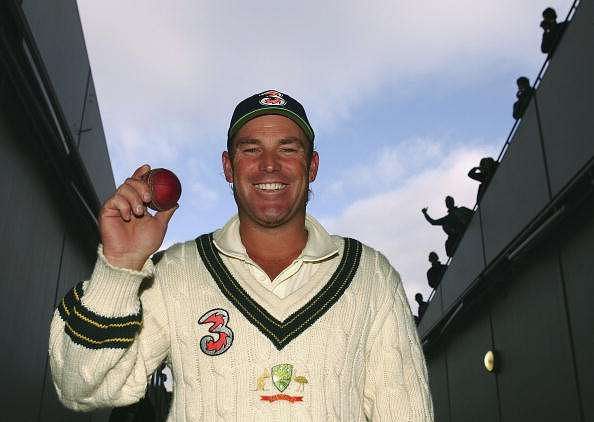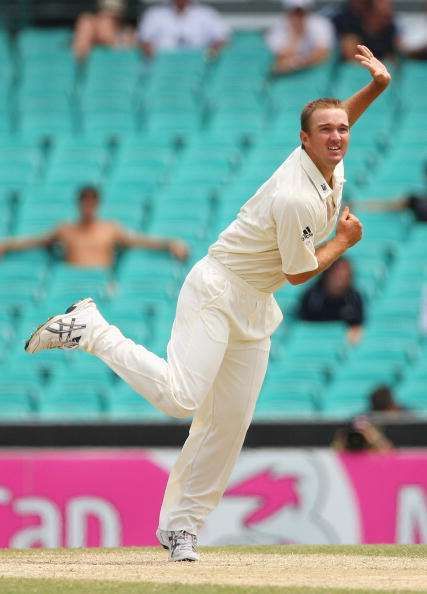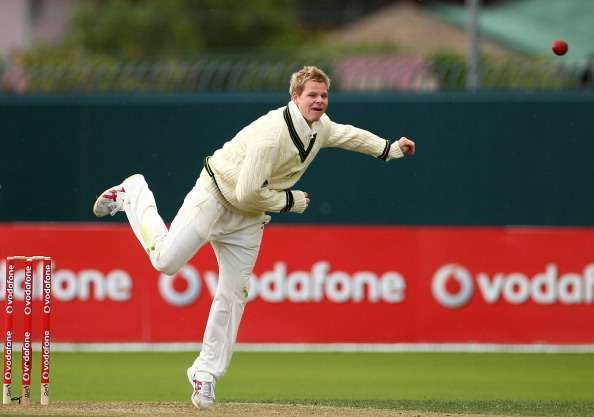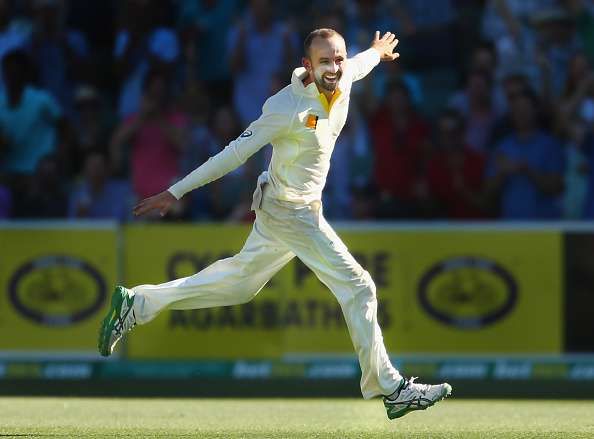
Australia's spinning woes: The post-Warne era
After much thought, Andrew Strauss quit international cricket one week post the drubbing at the hands of the visiting South Africans. He became the second England captain – following Michael Vaughan in 2008 – to resign from captaincy after defeat from Graeme Smith’s men. And ever since, England have lacked a solid opening batsman to partner incumbent captain Alastair Cook at the top.
They have tried Nick Compton, who got harshly dropped after two hundreds in the last four of the nine Tests he played; Joe Root joined Cook for the Ashes at home in 2013, but was replaced by Michael Carberry for the return Ashes during the winter of the same year following an average of just under 38.
When Carberry failed on the fast tracks of Australia, in came Sam Robson for the next two home series; upon Robson’s departure for low scores, Jonathan Trott returned to the England set-up with a new batting position which proved ultimately unsuccessful; Yorkshire’s Adam Lyth found his place in the eleven on Trott’s immediate retirement; seven Tests – and a hundred – for Lyth later, a visit to the UAE saw Moeen Ali occupy the opener’s slot; and when that experiment went in vain, England chose Alex Hales for the tour of South Africa, where he had only a single half-century to show out of eight innings.
Brad Hogg-Stuart MacGill
On similar lines had England’s arch-rivals from Down Under fared, save that they had to deal with the fixing of the spinner’s slot. The world’s most gifted leg spinner Shane Warne hung up his boots post the Ashes whitewash of England in 2006-07 and Australia jostled to find his replacement since.
When Warne left, Australia first recalled their then ODI regular chinaman bowler Brad Hogg into the Test team. Until his final incarnation as a Test match player during the home summer of 2007-08 against India, Hogg had nine wickets to show in four Tests.
The previous of his long form games came at Sydney against Zimbabwe in 2003, where too he played as a replacement for the canny leg spin of the unfit Stuart MacGill. Hogg could not replicate his one-day heroics on his comeback to Tests, averaging above 60 in the three matches that he participated – he is more remembered for his match-saving effort of 79 with the bat in the controversial Sydney Test – and retired from international cricket in early 2008 following the subsequent tri-series also involving Sri Lanka.
Though he returned to don Australian colours in 2012, they were only for T20 Internationals, the last of which came during the World T20 of 2014.
Six different spinners used in 2008
On the Kangaroos’ first foreign trip post-Warne, when they toured the Caribbean islands in mid-2008, MacGill played two Tests and retired with one remaining. That opened the door for the left-arm wrist spin of Beau Casson, only to be discarded after a single game; and during the Indian autumn of 2008, when Australia reciprocated with a tour, they had a trio of spinners on board.
While Cameron White had a role to play in all four Tests, averaging nearly 70 with the ball stalled his Test career; Jason Krejza’s historic 8 for 215 on debut – he got 12 in the match – during the final Test found him a place in the eleven only once more, when South Africa visited his nation later in the year, and only a single wicket on a pacer’s paradise in Perth had him dropped; and Bryce McGain had to wait until just before his thirty-seventh birthday to sport the revered Baggy Green while on a tour to play the Proteas in 2009, never to have worn it again after a wicketless debut.
In between Krejza’s appearances, his weak ankle allowed off-spinner Nathan Hauritz to have a go, as Australia roped him in for the second Test against New Zealand at Adelaide in 2008 – they played no spinner in Brisbane – who first rolled his arms round for his country in the low-scoring drama against India at Mumbai in 2004.
That meant Australia had tried and tested six slow bowlers within almost – and merely – two years of Warne’s departure and all of them played in 2008 alone.
Hauritz continued to be a part of Australia’s plans when he was named in the squad to fly to South Africa – alongside McGain – in 2009, but was luckless enough to not play a part in either of the three Tests, as Australia managed with the part-timers Michael Clarke, Marcus North and Simon Katich in the first two.
Instead, it was the ageing McGain who finally gained a place for the inconsequential third Test, but never again so.
Enter Steven Smith
However, Queenslander Hauritz was encouraged when he was not only chosen for the Ashes in England four months later but also was the only specialist spinner in the touring party. He averaged 32, 33 and 23 during the Ashes, and home campaigns against the West Indies and Pakistan, respectively.
But that had swollen to 65 each when the Aussies contested New Zealand and India for two Tests apiece on their next visit; and during the two neutral Tests against Pakistan in the British Isles separating the above tours, a stress issue in his foot gave Australia’s present skipper Steven Smith a look in.
To such extent had Australia’s struggles spread that even their current skipper Smith was initially drafted into the national side primarily for his leg spinners. Smith, at 20 years old then, batted at number nine – he bats in the top four today – and made his debut in the first Test purely as a leg spinner.
It had been quite a while since Australia brought on another slow bowler, Hauritz continuing to occupy the selectors’ mind since the Ashes of 2009. But he was handed a blow when out of the blue, they ditched him for the left arm orthodox spin of Xavier Doherty for the 2010-11 return Ashes, considering the majority of right-handed batsmen in England’s line-up.
Hauritz never played Test cricket for Australia again. Soon after, Doherty too fell out of their radar when he could collect only three English wickets after the first two Tests. Smith substituted him for the next two before accompanying another left armer Michael Beer in Sydney for the final match.
The worker at the Adelaide Oval
It was about time that Australia now turned their eyes to other options with a visit to Sri Lanka pending after the 2011 World Cup. So along with Beer, the worker at the Adelaide Oval, who charmed all with his right arm off spinners first at friendly net sessions and then in the domestic circuit, was picked to bowl to the likes of veterans Kumar Sangakkara and Mahela Jayawardene among others.
He was Nathan Lyon, a former ground staff at the Adelaide Oval, whose rise has contributed to many strong stints they have enjoyed. Lyon burst on to the international scene with a bang, bagging 5/34 on debut in the first innings in Galle.
Fortunately, he has made it to all seventeen Test series – home or away – that Australia have encountered since the fruitful Sri Lanka tour. During his maiden home Test, against New Zealand at Brisbane in 2011, Lyon bagged 7/88 in the match, still the best by an Australian off-spinner at the venue.
In the 2014-15 summer against India, when Lyon’s figures in Adelaide read an impressive yet expensive 5/134 and 7/152, he entered the record books by registering the best ever performance by a spinner against India in a Test match, a feat yet unmatched. Australia clinched victory by 48 runs when India first dared, and then threatened, to chase 364 on the final day and run away with the match.
Lyon was also impressive on a seamer’s deck at Edgbaston in 2015, with figures of 3/3 after three overs on a green pitch aiding lateral movement, eventually finishing with 3/36.
Such was the poor state of spinners that Lyon became the first Australian off-spinner to play 50 Tests when Australia played the West Indies at Hobart late in 2015. By then, he already possessed 172 Test victims at a fair average of 34, and his 142nd – also against the West Indies but at Sabina Park earlier in the year – made headlines, as he thus became his country’s leading off-spinner, surpassing the crafty Hugh Trumble, one of the smartest from his land and also one of only four international bowlers to have taken two hat-tricks in Test cricket.
But like all his predecessors, a debacle was in Lyon’s share too. He was first ignored on a quick track at the WACA against India in 2012; one year later, after being brutally hammered by MS Dhoni in Chennai, Doherty was preferred – this time to Lyon but again for the same reason – for the following match in Hyderabad; and it was astonishing to find a third left armer in Ashton Agar, with merely 10 matches at the domestic level, at Trent Bridge and Lord’s in the 2013 Ashes.
With a 98 at the Bridge, Agar remains the leader amongst scores by a number 11 in Test cricket – his only memorable contribution in those two games.
Australia have used Doherty only once more – in the match after Hyderabad while on the India tour in 2013 – while left-handed Steve O’Keefe debuted in the UAE against Pakistan in 2014 and got a second crack when the selectors chose him for taking on the West Indies in Lyon’s fifty-first Test at Sydney in 2016 – both alongside their first choice spin bowler.
Right from Hogg until they finally settled on Lyon, twelve tweakers – and thirteen including Smith – have been utilised by Australia in search of the next Warne. And the scenario doesn’t suggest they would be looking for another until Lyon loses form like a tight fist drops sand. Their count and search both have been halted. Indeed, they had to explore, they don’t have to anymore.
But their foes England might just have to hunt for captain Cook’s next partner – on the back of eight failed trials – four years after his former teammate Strauss quit, when they play their next Test series, which begins at Headingley against Sri Lanka in May, 2016. Maybe England will have reached – or breached – a dozen choices themselves.



